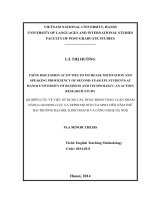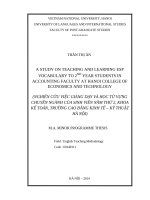Lecture Web technology and online services: Lesson 4 - Javascript
Bạn đang xem bản rút gọn của tài liệu. Xem và tải ngay bản đầy đủ của tài liệu tại đây (718.46 KB, 46 trang )
Javascript
1
Content
Client-side programming with JavaScript
▪ scripts vs. programs
JavaScript vs. JScript vs. VBScript
common tasks for client-side scripts
▪ JavaScript
data types & expressions
control statements
functions & libraries
strings & arrays
Date, document, navigator, user-defined classes
2
Client-Side Programming
❖ HTML is good for developing static pages
▪ can specify text/image layout, presentation, links, …
▪ Web page looks the same each time it is accessed
❖ Client-side programming
▪ programs are written in a separate programming (or scripting)
language
e.g., JavaScript, JScript, VBScript
▪ programs are embedded in the HTML of a Web page, with (HTML) tags
to identify the program component
e.g., <script type="text/javascript"> … </script>
▪ the browser executes the program as it loads the page, integrating the
dynamic output of the program with the static content of HTML
▪ could also allow the user (client) to input information and process it,
might be used to validate input before it’s submitted to a remote
server
3
Scripts vs. Programs
❖
A scripting language is a simple, interpreted programming language
▪ scripts are embedded as plain text, interpreted by application
▪ simpler execution model: don't need compiler or development environment
▪ saves bandwidth: source code is downloaded, not compiled executable
▪ platform-independence: code interpreted by any script-enabled browser
▪ but: slower than compiled code, not as powerful/full-featured
JavaScript: the first Web scripting language, developed by Netscape in 1995
syntactic similarities to Java/C++, but simpler, more flexible in some
respects,
limited in others (loose typing, dynamic variables, simple objects)
JScript: Microsoft version of JavaScript, introduced in 1996
• same core language, but some browser-specific differences
• fortunately, IE, Netscape, Firefox, etc. can (mostly) handle both
VBScript: client-side scripting version of Microsoft Visual Basic
4
Common Scripting Tasks
❖ adding dynamic features to Web pages
▪ validation of form data (probably the most commonly used
application)
▪ image rollovers
▪ time-sensitive or random page elements
▪ handling cookies
❖ defining programs with Web interfaces
▪ utilize buttons, text boxes, clickable images, prompts, etc
❖ limitations of client-side scripting
▪ since script code is embedded in the page, it is viewable to the world
▪ for security reasons, scripts are limited in what they can do
e.g., can't access the client's hard drive
▪ since they are designed to run on any machine platform, scripts do not
contain platform specific commands
▪ script languages are not full-featured
e.g., JavaScript objects are very crude, not good for large project
development
5
JavaScript
❖ JavaScript code can be embedded in a Web page using <script> tags
▪ the output of JavaScript code is displayed as if directly entered in HTML
<html>
js01.html
16.08.06 -->
<head>
<title>JavaScript Page</title>
</head>
<body>
<script type="text/javascript">
// silly code to demonstrate output
document.write("
Hello
world!
document.write("
How are
"
document.write displays text in the page
text to be displayed can include HTML tags
the tags are interpreted by the browser when
the text is displayed
as in C++/Java, statements end with ;
but a line break might also be interpreted as the end
of a statement (depends upon browser)
JavaScript comments similar to C++/Java
+
" <i>you</i>? ");
</script>
//
starts a single line comment
/*…*/ enclose multi-line comments
Here is some static text as
well.
</body>
</html>
view page
6
JavaScript Data Types & Variables
❖
JavaScript has only three primitive data types
String : "foo"
Number: 12
Boolean : true
<html>
js02.html
'how do you do?'
"I said 'hi'."
""
3.14159
1.5E6
false
*Find info on Null, Undefined
16.08.06 -->
<head>
<title>Data Types and
Variables</title>
</head>
<body>
<script type="text/javascript">
var x, y;
x= 1024;
y=x; x = "foobar";
document.write("
x = " + y +
"
document.write("
x = " + x +
"
</script>
</body>
view page
</html>
assignments are as in C++/Java
message = "howdy";
pi = 3.14159;
variable names are sequences of letters, digits, and
underscores that start with a letter or an underscore
variables names are case-sensitive
you don't have to declare variables, will be created
the first time used, but it’s better if you use var
statements
var message, pi=3.14159;
variables are loosely typed, can be assigned different
types of values (Danger!)
7
JavaScript Operators & Control Statements
<html>
08.10.10 -->
<head>
<title>Folding Puzzle</title>
</head>
<body>
<script type="text/javascript">
var distanceToSun = 93.3e6*5280*12;
var thickness = .002;
var foldCount = 0;
while (thickness < distanceToSun) {
thickness *= 2;
foldCount++;
}
document.write("Number of folds = "
standard C++/Java operators &
control statements are provided in
JavaScript
● +, -, *, /, %, ++, --, …
● ==, !=, <, >, <=, >=
● &&, ||, !,===,!==
● if , if-else, switch
● while, for, do-while, …
PUZZLE: Suppose you took a piece of
paper and folded it in half, then in half
again, and so on.
+
foldCount);
</script>
</body>
</html>
view page
How many folds before the thickness of
the paper reaches from the earth to the
sun?
*Lots of information is available online
8
JavaScript Math Routines
<html>
<!–- CS443 js04.html 08.10.10 -->
<head>
<title>Random Dice Rolls</title>
</head>
<body>
<div style="text-align:center">
<script type="text/javascript">
var roll1 = Math.floor(Math.random()*6) + 1;
var roll2 = Math.floor(Math.random()*6) + 1;
document.write("
roll1 + ".gif‘ alt=‘dice showing ‘ +
roll1 />");
document.write(" ");
document.write("
roll2 + ".gif‘ alt=‘dice showing ‘ +
roll2 />");
</script>
</div>
</body>
view page
</html>
the built-in Math object contains
functions and constants
Math.sqrt
Math.pow
Math.abs
Math.max
Math.min
Math.floor
Math.ceil
Math.round
Math.PI
Math.E
Math.random function returns a real
number in [0..1)
9
Interactive Pages Using Prompt
<html>
<!-- CS443 js05.html 08.10.10 -->
<head>
<title>Interactive page</title>
</head>
<body>
<script type="text/javascript">
var userName = prompt ("What is your name?",
"");
var userAge = prompt ("Your age?", "");
var userAge = parseFloat (userAge);
document.write("Hello " + userName + ".")
if (userAge < 18) {
document.write(" Do your parents know
" +
"you are online?");
}
else {
document.write(" Welcome friend!");
}
</script>
The rest of the page...
</body>
view page
</html>
crude user interaction can take
place using prompt
1st argument: the prompt message that
appears in the dialog box
2nd argument: a default value that will
appear in the box (in case the user
enters nothing)
the function returns the value entered
by the user in the dialog box (a string)
if value is a number, must use
parseFloat (or parseInt) to convert
forms will provide a better
interface for interaction (later)
10
User-Defined Functions
❖ function definitions are similar to C++/Java, except:
▪ no return type for the function (since variables are loosely typed)
▪ no variable typing for parameters (since variables are loosely typed)
▪ by-value parameter passing only (parameter gets copy of argument)
function isPrime(n)
// Assumes: n > 0
// Returns: true if n is prime, else false
{
if (n < 2) {
return false;
}
else if (n == 2) {
return true;
}
else {
for ( var i = 2; i <= Math.sqrt(n); i++)
{
if (n % i == 0) {
return false;
}
}
return true;
}
}
Can limit variable scope
to the function.
if the first use of a variable is
preceded with var, then
that variable is local to the
function
for modularity, should make
all variables in a function
local
11
Function Example
<html>
<!–- CS443 js06.html 16.08.2006 -->
<head>
<title>Prime Tester</title>
<script type="text/javascript">
function isPrime(n)
// Assumes: n > 0
// Returns: true if n is prime
{
// CODE AS SHOWN ON PREVIOUS SLIDE
}
</script>
</head>
<body>
<script type="text/javascript">
testNum = parseFloat(prompt("Enter a positive integer",
"7"));
if (isPrime(testNum) ) {
document.write(testNum + " <b>is</b> a prime number.");
}
else {
document.write(testNum + " <b>is not</b> a prime
number.");
}
</script>
</body>
view page
</html>
Function definitions
(usually) go in the
<head> section
<head> section is
loaded first, so then the
function is defined before
code in the <body> is
executed (and, therefore,
the function can be used
later in the body of the
HTML document)
12
Another Example
<html>
<!–- CS443 js07.html 11.10.2011 -->
<head>
<title> Random Dice Rolls Revisited</title>
<script type="text/javascript">
function randomInt(low, high)
// Assumes: low <= high
// Returns: random integer in range [low..high]
{
return Math.floor(Math.random()*(high-low+1)) + low;
}
</script>
</head>
<body>
<div style="text-align: center">
<script type="text/javascript">
roll1 = randomInt(1, 6);
roll2 = randomInt(1, 6);
document.write("<img src=' />"~martin/teaching/CS443/Images/die" +
roll1 + ".gif'/>");
document.write(" ");
document.write("<img src=' />"~martin/teaching/CS443/Images/die" +
roll2 + ".gif'/>");
</script>
</div>
</body>
view page
</html>
recall the dynamic dice
page
could define a function for
generating random numbers in
a range, then use whenever
needed
easier to remember, promotes
reuse
13
JavaScript Libraries
better still: if you define functions that may be useful to
many pages, store in a separate library file and load
the library when needed load a library using the SRC
attribute in the SCRIPT tag (put nothing between the
beginning and ending tags)
src="random.js">
</script>
14
Library Example
<html>
js08.html
11.10.2011 -->
<head>
<title> Random Dice Rolls Revisited</title>
src="random.js">
</script>
</head>
<body>
<div style="text-align: center">
<script type="text/javascript">
roll1 = randomInt(1, 6);
roll2 = randomInt(1, 6);
document.write("<img src=' />"~martin/teaching/CS443/Images/die" +
roll1 + ".gif'/>");
document.write(" ");
document.write("<img src=' />"~martin/teaching/CS443/Images/die" +
roll2 + ".gif'/>");
</script>
</div>
</body>
</html>
view page
15
JavaScript Objects
❖ an object defines a new type (formally, Abstract Data Type)
▪ encapsulates data (properties) and operations on that data (methods)
❖ a String object encapsulates a sequence of characters,
enclosed in quotes
properties include
•
length
: stores the number of characters in the string
methods include
: returns the character stored at the given index (as in C++/Java,
•
charAt(index)
•
substring(start, end)
•
•
indices start at 0)
: returns the part of the string between the start (inclusive)
and end (exclusive) indices
toUpperCase()
: returns copy of string with letters uppercase
toLowerCase()
: returns copy of string with letters lowercase
to create a string, assign using new or (in this case) just make a direct assignment (new is implicit)
word = new String("foo");
word = "foo";
properties/methods are called exactly as in C++/Java
•
word.length
word.charAt(0)
16
String example: Palindromes
function strip(str)
// Assumes: str is a string
// Returns: str with all but letters removed
{
var copy = "";
for (var i = 0; i < str.length ; i++) {
if (( str.charAt(i) >= "A" && str.charAt(i) <= "Z")
||
( str.charAt(i) >= "a" && str.charAt(i) <= "z"))
{
copy += str.charAt(i) ;
}
}
return copy;
}
function isPalindrome(str)
// Assumes: str is a string
// Returns: true if str is a palindrome, else false
{
str = strim(str.toUpperCase()) ;
for(var i = 0; i < Math.floor( str.length /2); i++) {
if (str.charAt(i) != str.charAt(str.length-i-1) ) {
return false;
}
}
return true;
suppose we want to test
whether a word or phrase
is a palindrome
noon
Radar
Madam, I'm Adam.
A man, a plan, a canal:
Panama!
must strip non-letters out of the word or
phrase
make all chars uppercase in order to be
case-insensitive
finally, traverse and compare chars from
each end
}
17
<html>
<!–- CS443 js09.html 11.10.2011 -->
<head>
<title>Palindrome Checker</title>
<script type="text/javascript">
function strip(str)
{
// CODE AS SHOWN ON PREVIOUS SLIDE
}
function isPalindrome(str)
{
// CODE AS SHOWN ON PREVIOUS SLIDE
}
</script>
</head>
<body>
<script type="text/javascript">
text = prompt("Enter a word or phrase", "Madam, I'm
Adam");
if ( isPalindrome(text) ) {
document.write("'" + text + "' <b>is</b> a
palindrome.");
}
else {
document.write("'" + text + "' <b>is not</b> a
palindrome.");
}
view page
</script>
</body>
</html>
18
JavaScript Arrays
❖ arrays store a sequence of items, accessible via an
index
since JavaScript is loosely typed, elements do not have to be the same
type
▪ to create an array, allocate space using new (or can assign
directly)
items = new Array(10); // allocates space for 10 items
items = new Array();
// if no size given, will adjust dynamically
items = [0,0,0,0,0,0,0,0,0,0]; // can assign size & values []
▪ to access an array element, use [] (as in C++/Java)
for (i = 0; i < 10; i++) {
items[i] = 0;
// stores 0 at each index
}
▪ the length property stores the number of items in the array
for (i = 0; i < items.length; i++) {
document.write(items[i] + "
");
}
// displays elements
19
Array Example
<html>
<!–- CS443 js10.html 11.10.2011 -->
<head>
<title>Dice Statistics</title>
src=" />ndom.js">
</script>
</head>
<body>
<script type="text/javascript">
numRolls = 60000;
diceSides = 6;
rolls = new Array(dieSides+1);
for (i = 1; i < rolls.length ; i++) {
rolls[i] = 0;
}
for(i = 1; i <= numRolls; i++) {
rolls[randomInt(1, dieSides)]++;
}
for (i = 1; i < rolls.length ; i++) {
document.write("Number of " + i + "'s = " +
rolls[i] + "
");
}
</script>
</body>
view page
</html>
suppose we want to
simulate dice rolls and verify
even distribution
keep an array of counters:
initialize each count to 0
each time you roll X, increment
rolls[X]
display each counter
20
Arrays (cont.)
• Arrays have predefined methods that allow them to be
used as stacks, queues, or other common programming
data structures.
var stack = new Array();
stack.push("blue");
stack.push(12);
stack.push("green");
var item = stack.pop();
//
//
stack is now the array ["blue", 12]
stack = ["blue", 12, "green"]
// item is now equal to "green"
var q = [1,2,3,4,5,6,7,8,9,10];
item = q.shift();
// item is now equal to 1, remaining
// elements of q move down one position
// in the array, e.g. q[0] equals 2
q.unshift(125); // q is now the array [125,2,3,4,5,6,7,8,9,10]
q.push(244);
// q = [125,2,3,4,5,6,7,8,9,10,244]
21
Date Object
❖ String & Array are the most commonly used objects in
JavaScript
▪ other, special purpose objects also exist
❖ the Date object can be used to access the date and time
▪ to create a Date object, use new & supply year/month/day/… as
desired
today = new Date();
// sets to current date & time
newYear = new Date(2002,0,1); //sets to Jan 1, 2002 12:00AM
▪ methods include:
newYear.getFullYear()
newYear.getMonth()
newYear.getDay()
newYear.getHours()
newYear.getMinutes()
newYear.getSeconds()
newYear.getMilliseconds()
can access individual components of a date
number (0,
number (1, 31)
number (0,
number (0,
number (0,
number (0,
11)
23)
59)
59)
999)
22
Date Example
<html>
<!–- CS443 js11.html 16.08.2006 -->
<head>
<title>Time page</title>
</head>
<body>
Time when page was loaded:
<script type="text/javascript">
now = new Date();
document.write("
" + now + "
");time = "AM";
hours = now.getHours();
if (hours > 12) {
hours -= 12;
time = "PM"
}
else if (hours == 0) {
hours = 12;
}
document.write("
" + hours + ":" +
now.getMinutes() + ":" +
now.getSeconds() + " " +
time + "
</script>
</body>
view page
</html>
by default, a date will be displayed in full,
e.g.,
Sun Feb 03 22:55:20 GMT-0600
(Central Standard Time) 2002
can pull out portions of the date using the
methods and display as desired
here, determine if "AM" or "PM" and adjust
so hour between 1-12
10:55:20 PM
23
Another Example
<html>
<!–- CS443 js12.html 12.10.2012 -->
<head>
<title>Time page</title>
</head>
<body>
Elapsed time in this year:
<script type="text/javascript">
now = new Date();
newYear = new Date(2012,0,1);
secs = Math.round((now-newYear)/1000);
days = Math.floor(secs / 86400);
secs -= days*86400;
hours = Math.floor(secs / 3600);
secs -= hours*3600;
minutes = Math.floor(secs / 60);
secs -= minutes*60
document.write(days + " days, " +
hours + " hours, " +
minutes + " minutes, and " +
secs + " seconds.");
</script>
</body>
view page
</html>
you can add and subtract Dates:
the result is a number of milliseconds
here, determine the number of
seconds since New Year's day
(note: January is month 0)
divide into number of days, hours,
minutes and seconds
24
Document Object
Internet Explorer, Firefox, Opera, etc. allow you to access
information about an HTML document using the document object
<html>
<!–- CS443 js13.html 2.10.2012 -->
<head>
<title>Documentation page</title>
</head>
<body>
<table width="100%">
<tr>
<td><i>
<script type="text/javascript">
document.write(document.URL) ;
</script>
</i></td>
<td style="text-align: right;"><i>
<script type="text/javascript">
document.write(document.lastModified) ;
</script>
</i></td>
</tr>
</table>
</body>
view page
</html>
document.write(…)
method that displays text in the page
document.URL
property that gives the location of
the HTML document
document.lastModified
property that gives the date & time
the HTML document was last
changed
25









